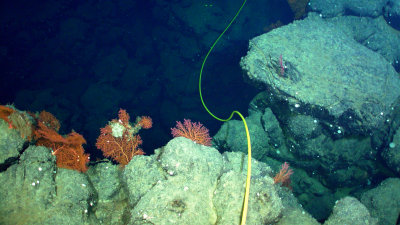Two submarine cables are cut and the Internet in Africa falls into chaos, and there are cases where the delay is improved despite the cable disconnection

On Sunday, August 6, 2023, local time, a landslide occurred in one of the world's longest submarine canyons, cutting two critical submarine cables that provide Internet services to Africa. As a result, Internet
Dual Subsea Cable Cuts Disrupt African Internet | Kentik Blog
https://www.kentik.com/blog/dual-subsea-cable-cuts-disrupt-african-internet/

On August 6, 2023, a landslide occurred in the Congo Valley, the world's longest submarine canyon, near the mouth of the Congo River , which straddles the Democratic Republic of the Congo and Angola. As a result, two submarine cables ' WACS ' with a total length of about 14,000 km connecting the west coast of England and South Africa and ' SAT-3 ' connecting the west coast countries of Portugal, Spain and South Africa were cut. The SAT-3 failed first, and a few hours later the WACS also failed.
The location of the Congo Canyon where the landslide occurred is as follows.
The dark blue part extending from the land to the sea in the image below is the Congo Valley.

The greatest threat to submarine cables, which are the infrastructure that forms the world's Internet network, is ``marine activity by humans''. The most common reason for cutting a submarine cable is that ``a fishing boat hooks an anchor on the submarine cable during fishing and cuts the cable''.
The second biggest threat to submarine cables is nature. Undersea cables are often severed by landslides and earthquakes that occur on the seafloor, and the Hengchun earthquake that occurred off the south coast of Taiwan in December 2006 severed several submarine cables. This has paralyzed the Internet communication network in East Asia.
The International Cable Protection Commission (ICPC) said about the impact of the Hengchun earthquake, ``There were 21 failures in 9 submarine cables, and it took 49 days using 11 ships to restore everything to normal. There was an announcement .

In addition, a Japanese speaker introduced efforts to repair submarine cables damaged by the 2011

This is not the first time that two submarine cables, SAT-3 and WACS, have been severed due to landslides. A study published in June 2021 reported that SAT-3 and WACS were damaged by a large-scale submarine landslide at the mouth of the Congo River in 2020.
Also, in 2022, an accident occurred in Egypt, Africa, where terrestrial cables were cut and several submarine cable services were temporarily suspended. At this time, Kentik independently analyzed the impact on network connectivity of major cloud providers such as AWS, Azure, and Google Cloud, proving once again that even major cloud services rely on submarine cables. .
The graph below shows the communication performance from the AWS region in Cape Town, South Africa to London, England when the submarine cable was cut on August 6, 2023. The graph shows the latency (delay) of the network, and you can see that the latency increases sharply in the red frame. This is because when routing AWS traffic from Cape Town to London, a cable failure occurred and a different route was adopted than usual, and the route lengthened the latency from '150 ms' to ' It seems that it has increased to 195 milliseconds.

On the other hand, the network latency from Cape Town to South Korea and Seoul in Asia has decreased from '386 ms' to '304 ms'. Regarding the reduction in latency, Kentik said, ``The longer and longer delay routes that are normally used may become unavailable, causing traffic to take a more straight and shorter path, resulting in shorter delays.'' is mentioned.
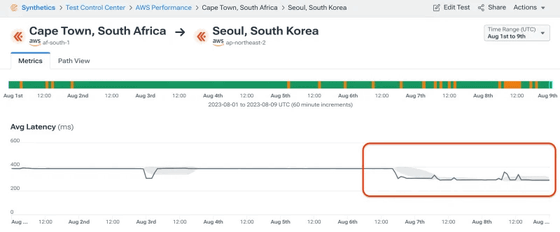
In addition, regarding 'the reason why traffic must pass through a route with a larger delay on a daily basis', Kentik said, 'In this case, the 'route with the lowest delay' connecting Cape Town and Seoul is because the cost is too high. ” explains.
The graph below monitors the network traffic when the submarine cable was cut in August 2023. Kentik data shows that South Africa's largest network operator is
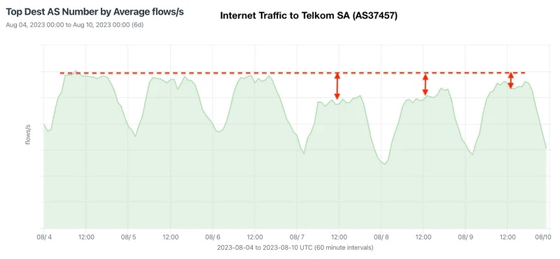
In Namibia, West Africa, government-owned telecom operator Telecom Namibia lost about two hours of
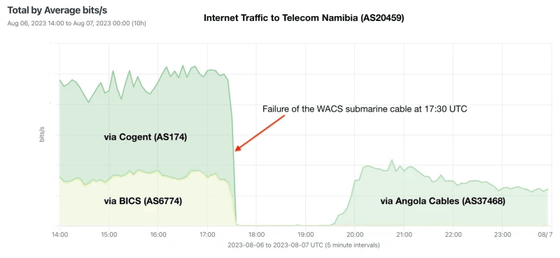
In the case of Telecom Namibia, the transit from AS174 (Cogent) and AS6774 (BICS) was lost around 17:30 local time on August 6th, and the transit from AS37468 (cable via Angola) was lost around 19:00 on August 6th. and restore network traffic.
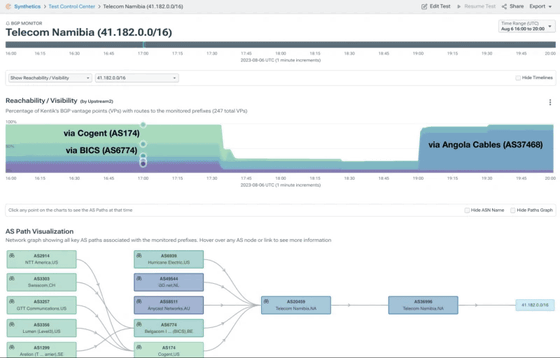
The cable repair ship '
Where is a cable repair ship when you need one? With WACS and SAT3 cables cut in the Congo Canyon (again) on the WEST Side of the continent, we find the ship that is needed to fix them is docked on the East of Africa https ://t.co/VOqi6DWCSx pic.twitter.com/3ar86GyVY1
— Ben Roberts ?????????????????? (@benliquidkenya) August 9, 2023
West Africa's network traffic is distributed over other submarine cables, such as Google's Equiano cable, which opened in early 2023. Like WACS and SAT-3, Equiano is a submarine cable along the west coast of Africa, but has not been affected by submarine landslides, which Equiano client Liquid Dataport emphasizes . doing.
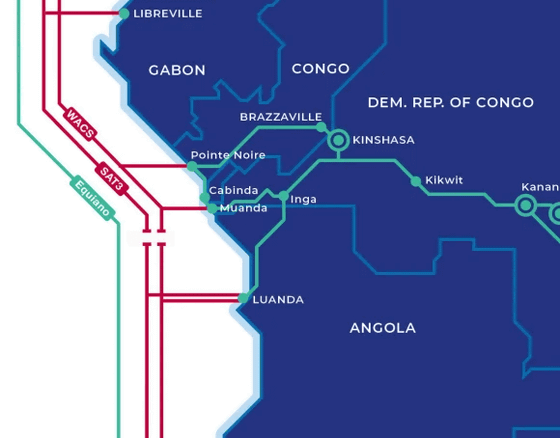
Related Posts:
in Web Service, Posted by logu_ii

